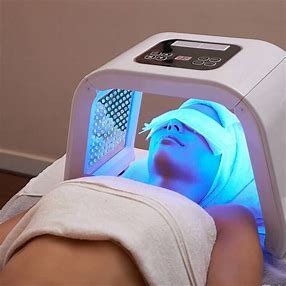
LED LIGHT THERAPY
WhAT IS LED LIGHT THERAPY?
LED (light-emitting diode) light therapy is a non-invasive treatment that enters the skin’s layers to improve the skin.
Overview
What is LED light therapy?
LED (light-emitting diode) light therapy is a non-invasive treatment that enters the skin’s layers to improve the skin.
In the 1990s, NASA began studying LED’s effects in promoting wound healing in astronauts by helping cells and tissues grow.
Today, dermatologists and estheticians commonly use LED light therapy to treat a range of skin issues. Skin specialists often use LED light therapy together with other treatments, such as creams, ointments and facials, to give you the best results.
You can also buy an array of at-home devices that use LED light therapy, including LED masks.
What does LED light therapy do?
LED light therapy helps treat a variety of skin concerns and conditions, including:
Eczema.
Hair loss.
Mild to moderate acne.
Psoriasis.
Rough, scaly, precancerous spots on the skin (actinic keratosis).
Rosacea.
Sun damage.
Wounds.
Wrinkles.
In some cases, LED light therapy may treat small and superficial basal cell carcinoma (BCC). BCC, a skin cancer, is the most common type of cancer, affecting about 3.6 million Americans each year.
Arrange your consultation here!
ARE THERE DIFFERENT KINDS OF LIGHT THERAPY?
LED light therapy uses various wavelengths that correspond to different visible colors. Each color penetrates the skin at different depths.
Blue light affects the uppermost layer of your skin.
Yellow light penetrates deeper.
Red light travels further into your skin.
Near-infrared light penetrates deepest.
Different LED colors do different things. For example, experts believe:
Red LED light therapy may reduce inflammation and stimulate the production of collagen, a protein responsible for younger-looking skin that diminishes with age.
Blue LED light therapy may destroy acne-causing bacteria (P. acnes).
During treatment, skin specialists may use a combination of lights to treat your specific issue. At-home devices may also combine colors..
Risks / Benefits
What are the benefits of LED light therapy?
LED light therapy might:
Treat acne.
Reduce fine lines.
Help with wound healing.
People with any skin type and color can use LED light therapy. LED light therapy doesn’t use ultraviolet (UV) light, so it doesn’t cause damage or burns to your skin.
What are the risks of LED light therapy?
LED light therapy is a safe, relatively risk-free treatment. If you’re thinking about buying an at-home mask or device, be sure it’s marked “FDA cleared” or “FDA approved.” Also, wear eye protection, such as sunglasses or goggles, and carefully follow instructions to confirm you’re using the device correctly.
It’s rare to experience side effects from LED light therapy. If side effects do occur, they may include:
Increased inflammation.
Rash.
Redness.
Pain.
Experts do caution that while LED light therapy seems to be safe in the short term, there’s less information about its long-term safety.
How can I make sure LED light therapy is right for me?
Before going to a spa for LED light therapy or buying an at-home device, consider consulting a dermatologist. This way, you can receive the correct diagnosis and treatment for your skin issue. What looks like aging, blemished skin, for example, may really be skin cancer.
Consulting a dermatologist can also confirm whether in-office or at-home LED light therapy is a good treatment option for your needs.
Recovery and Outlook
What is the recovery time after LED light therapy?
There isn’t a recovery time for LED light therapy. Besides being careful about sun exposure in the 48 hours after treatment, you can return to your normal routine. Unlike other skin treatments, such as a chemical peel, there isn’t any damage to the skin.


